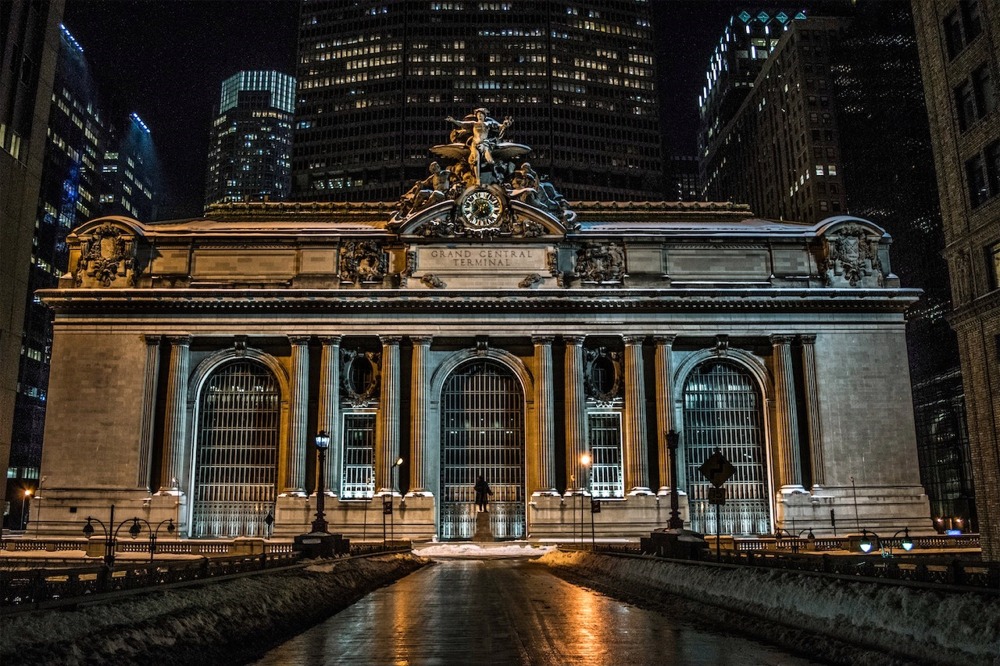Grand Central Terminal
42nd Street Facade
Home > New York State Photographs > New York > Grand Central Terminal 42nd Street Facade

The epic 42nd Street facade of Grand Central Terminal in Manhattan shines, the Beaux-Arts style a masterpiece of classic beauty. At its apex is the Glory of Commerce, an awe-inspiring sculpture by Jules-Félix Coutan, its intricate clock a marvel of craftsmanship often referred to as a Tiffany Clock. Below this work of art are three grand arches which frame the statue of Cornelius Vanderbilt, originator of the 42nd street Grand Central Depot that would later become Grand Central Terminal. An array of massive columns and intricately carved ornamentation line the building's exterior. Illuminated by night lighting, the famed terminal basks in a regal patina hue of brown. Swirling snow blankets the ground outside, adding to the wintery atmosphere that surrounds this grand landmark.
.Grand Central Terminal
Grand Central Terminal, often simply referred to as Grand Central, is a historic transportation hub located in the heart of Manhattan, New York City. It is one of the city's most iconic and recognizable landmarks, renowned for its stunning Beaux-Arts architecture, intricate details, and significance in both transportation and cultural history.
Here are some key points about Grand Central Terminal:
History and Construction
Grand Central Terminal was conceived as a replacement for the older Grand Central Station which in turn, was a reconstruction of the original Grand Central Depot which had become inadequate for the growing transportation needs of New York City. Construction began in 1903, and the terminal officially opened to the public in 1913.
Architectural Marvel
The terminal's architecture was designed by the architectural firms Reed and Stem, and Warren and Wetmore. Its design is characterized by the Beaux-Arts style, which emphasizes grandeur, symmetry, and ornate detailing. The exterior features a monumental façade with large windows, sculptures, and intricate decorations.
Main Concourse
The Main Concourse is the most iconic feature of the Grand Central Terminal. It is a vast, cathedral-like space with a stunning celestial mural on the ceiling known as the "Grand Central Celestial Ceiling." The mural depicts constellations and stars on a green background and has become one of the terminal's most recognizable elements.
Information Booth and Clock
The iconic information booth is in the center of the Main Concourse, topped by a four-faced clock made from opalescent glass (opal glass). This clock is a popular meeting spot for commuters and tourists alike.
Transportation Hub
Grand Central Terminal serves as a major transportation hub for New York City. It primarily serves the Metro-North Railroad, providing train services to the northern suburbs of New York and Connecticut. The terminal also has connections to the New York City Subway, making it an essential point of transit for thousands of daily commuters.
Shops and Dining
Grand Central Terminal is not just a transportation hub; it's also a shopping and dining destination. The terminal houses numerous shops, boutiques, and restaurants, offering a variety of goods and cuisine to both commuters and visitors.
Restoration and Preservation
In the late 20th century, Grand Central Terminal faced the threat of demolition due to changing transportation needs. However, a successful preservation campaign led to the terminal being placed on the National Register of Historic Places in 1976. A comprehensive restoration effort was undertaken to bring the terminal back to its original glory.
Cultural Significance
Grand Central Terminal has appeared in numerous movies, TV shows, and books, making it a symbol of New York City in popular culture. Its beauty and grandeur have also made it a popular spot for tourists, photographers, and artists.
Grand Central Terminal stands as a testament to the architectural and engineering achievements of its time while remaining a vital part of New York City's transportation network. Its blend of historic significance, architectural beauty, and functional importance continues to make it a beloved and iconic landmark.


